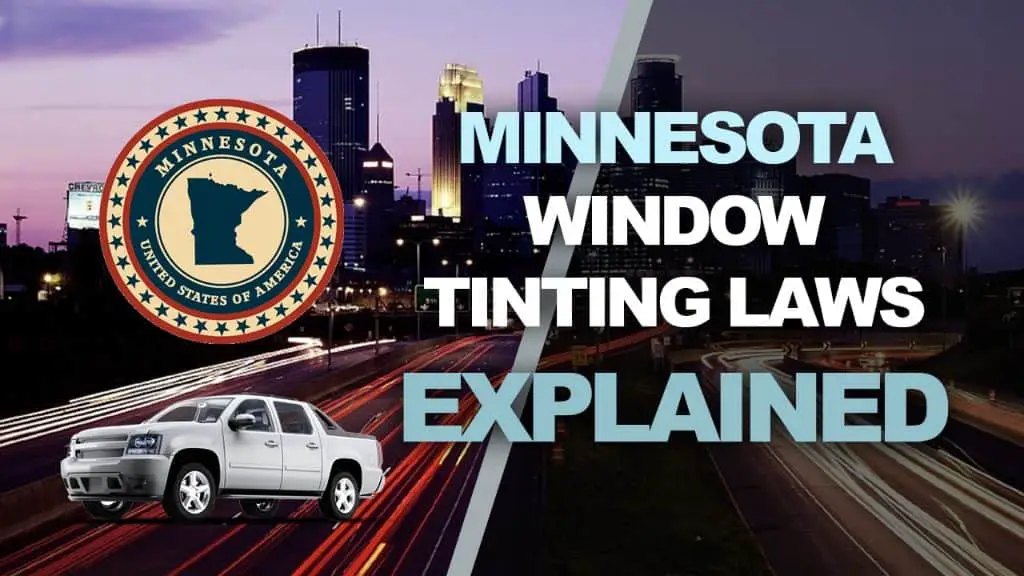

Article Created by Ryan Pietrzak
Last updated on February 14, 2024Minnesota Tint Laws – 2024 Updated Legal Tint Limit
Please note that Minnesota Tint Laws Regulation can change daily and may be interpreted differently at the city or county level. We recommend verifying this information with your local DMV or law enforcement agencies. We have manually fact-checked this content using official state resources. Minnesota enacted tinting laws in 1985. If any information provided is incorrect or outdated, please contact us so we can make the necessary corrections. Thank you.
2024 Minnesota Tint Laws – Legal Tint Limit For Passenger Vehicles
- Front Windshield: Non-reflective tint is allowed on the top 6 inches of the windshield.
- Front seat side windows: up to 50% tint darkness allowed.
- Back seat side windows: up to 50% tint darkness allowed
- Rear window: up to 50% tint darkness allowed
- Medical exemption – With a doctor’s note, darker tint is allowed on the front sides for medical reasons.
2024 Minnesota Tint Laws – Legal Tint Limit For Multi-Purpose Vehicles
- Front Windshield: Non-reflective tint is allowed on the top 6 inches of the windshield.
- Front seat side windows: up to 50% tint darkness allowed
- Back seat side windows: Must allow more than 50% of light in.
- Rear window: Must allow more than 50% of light in.

- Medical exemptions: Minnesota tint laws permit darker tints on front side windows with a doctor’s note
- Minnesota tint laws prohibit metallic or reflective tint on any of the windows
- Minnesota tint laws are statewide with no additional local regulations
- Violating Minnesota tint laws for window tint typically ranges from $50 to $130. The exact amount can vary depending on the specific circumstances of the violation and the jurisdiction. Repeat offenses may result in higher fines.
What does VLT Mean according to Minnesota Tint Laws?
- Window tint film’s light transmission is measured as VLT (Visible Light Transmission) and each state has its own legal limits for VLT on car windows.
- A HIGHER VLT means that more light is allowed to pass through the window tint film.
- Example: a 75% tint will allow 75% of the light to pass through whereas a 5% tint will only allow 5% of the light to pass through, making the 5% tint a much darker film.
- Minnesota car window tint laws has specific VLT limits for Passenger Vehicles and Multi-Purpose Vehicles.
FAQ’s Regarding Minnesota Tint Laws and Minnesota Legal Tint Limit
What is the darkest legal tint in Minnesota?
In Minnesota, the darkest legal window tint is 50% VLT (Visible Light Transmission) for the front side windows, and any darkness can be used on the rear side and rear windows of passenger vehicles. This means the front side windows must allow at least 50% of the light to pass through.
Are police exempt from window tint laws in Minnesota?
Yes, in Minnesota, police vehicles are typically exempt from the state’s window tint laws. This exemption allows law enforcement vehicles to use window tint that is darker than the legal limit for regular passenger vehicles.
How do I get a tint waiver in Minnesota?
In Minnesota, to obtain a window tint medical exemption, you need to submit a completed Application for Special Vehicle Permit for Excessive Window Tint, which includes a statement from a licensed physician or optometrist. This statement must certify that you or a regular passenger in the vehicle has a medical condition that necessitates darker window tint. The application is reviewed by the Minnesota Department of Public Safety, and if approved, grants an exemption from the standard tint regulations.
How much is a tint ticket in Minnesota?
In Minnesota, the cost of a ticket for a window tint violation typically ranges from $50 to $130. The exact amount can vary depending on the specific circumstances of the violation and the jurisdiction. Repeat offenses may result in higher fines.
Can you get pulled over for tint in Minnesota?
Yes, in Minnesota, you can be pulled over by law enforcement if your vehicle’s window tint is suspected to be darker than the state’s legal limit. This could lead to a ticket or a requirement to remove the non-compliant tint.
How to get a Tint Exemption in Minnesota
Window tinting medical exemptions are permitted. Licensed physician’s prescription or statement must be in vehicle at all times. This statement must specify the minimum percentage of light transmittance (VLT) required to satisfy the medical needs of the patient.
This statement must also contain an expiration date, which must be no more than two years after the date it was issued.
For more information regarding window tint medical exemptions in _____ you can checkout this resource:

Ryan Pietrzak
Creator of Windowtintlaws.us
